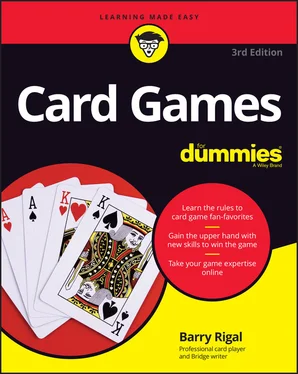296 305
297 306
298 307
299 308
300 309
301 310
302 311
303 312
304 313
305 314
306 315
307 316
308 317
309 318
310 319
311 320
312 321
313 322
314 323
315 324
316 325
317 326
318 327
319 328
320 329
321 330
322 331
323 332
324 333
325 334
326 335
327 336
328 337
329 338
330 339
331 340
332 341
333 342
334 343
335 344
336 345
337 346
338 347
339 348
340 349
341 350
342 351
343 352
344 353
345 354
346 355
347 356
348 357
349 358
350 359
351 360
352 361
353 362
354 363
355 364
356 365
357 367
358 368
359 369
360 370
361 371
362 372
363 373
364 374
365 375
366 376
367 377
368 378
369 379
370 381
371 382
372 383
Card games offer the most fascinating challenges that you may ever encounter. In most games, you can manipulate the 52 pieces of pasteboard into infinite permutations and combinations. Working out those combinations is the fun part of cards — in almost every game, you don’t know what the other players have in their hands. During the course of play, you use strategy, memory, cunning, and a whole host of other qualities to put together the best hand possible (or to bluff with the worst hand out there).
All in all, figuring out the fundamentals of a new card game can bring untold satisfaction. At the same time, you don’t have to play cards all that well in order to enjoy yourself. Card games allow you to make friends with the people you play with and against.
If you’ve never played a card game before, you may wonder why you need to buy a book about the subject. All your friends say the games are easy to pick up, so can’t you just sit down and start playing, picking up a few rules here and there? Obviously, I wouldn’t advise that!
Many card games have been in circulation for hundreds of years, generating scores of variations. A reference book not only explains the core rules of a game but also lists the main variations, to let you choose the rules you and your friends want to play by.
Card Games For Dummies, 3rd Edition, is different from every other card-game book on the shelf. So many books on cards simply don’t talk about the games people play today. The writers are experts in one or two of the games about which they write, but they remain novices at others. They rely on authors of other books to help them out, who were themselves dependent on previous authors. As a result, the games they describe may not be popular any more, or perhaps the games now have different rules. Many books, in other words, have lost touch with reality. Card Games For Dummies, 3rd Edition, has one or two introductory games in it such as Whist, but for the most part actually focuses on the games that people play today all around the world, especially newer crazes, such Texas Hold ’Em and Omaha.
Of course, I’m not an expert in every game, so this book has benefited enormously from a great deal of input from a host of game players who have answered my questions about the rules of the games in this book and about regional variations. The net result is that I’ve captured most of the popular variations to the standard games.
This book also differs from other gaming books because I wrote it in plain English. I eliminate as much card jargon as possible and concentrate on telling you how to get up and going. Of course, for games that do involve technical terms that may be new to you, I tell you exactly what each term means so that you can easily understand it.
Regardless of how much experience you’ve had with card games, you’ll find something here for you. Absolute beginners will appreciate that I discuss each game in this book starting at the very beginning, before a card hits the table. If you’ve played a few card games before, maybe you’ll try out a new game or pick up a variation on one of your favorites. (I can tell you that I’ve become hooked on several new games since I began researching this book. I’m sure you’ll have the same experience.)
However, I don’t limit my coverage of the games in this book to a description and a summary. Instead, each chapter offers hints on strategy, so even experienced players can pick up something new.
And in line with the wave of technology sweeping up the card game world, I tell you where to find information about a game on the Internet and point out places where you can play games online. (If you don’t have a computer, or you can’t tell the Internet from a hairnet, you won’t miss out on anything; I tell you everything you need to know about how to play a game right here in this book.) I’ve placed all the computer-related stuff in sidebars, where you can find the information easily if you want to read it or skip over it quickly if you have better things to do.
Just to show that one can improve on perfection, the third edition of Card Games For Dummies has an expanded section on Poker, Children’s Games, Solitaire, and a host of added variants on the traditional games.
Conventions Used in This Book
Throughout this book, I talk quite a bit about specific cards. Instead of constantly saying “the king of hearts” or “the 7 of spades” every time I refer to those cards, I abbreviate the cards and suits by using the following symbols:
The suits: I represent each of the four suits in a standard deck of cards with spade ♠, heart ♥, club ♣, and diamond ♦ symbols.
The card values: I use the following abbreviations to refer to specific card values: ace (A), king (K), queen (Q), jack (J), 10, 9, 8, 7, 6, 5, 4, 3, and 2.
When I refer to a specific card in the text, you see ♥K and ♠7 rather than “the king of hearts” or “the 7 of spades.”
I show you entire hands of cards in figures to help you see what a set of cards looks like when you’re actually holding it in your hand.
During the printing of this book, some Web addresses may have broken across two lines of text. If you come across such a situation, rest assured that we haven’t put in any extra characters (such as hyphens) to indicate the break. So, when using one of these Web addresses, type in exactly what you see in this book, pretending as though the line break doesn’t exist.
For the most part, I’ve tried to avoid using more technical jargon than is absolutely necessary. However, the book does include some sidebars that give you historical perspective on how certain games were created or about where you can go online for additional information about specific games. These are asides and not critical to the text. You can spot them easily enough — the text is on a shaded background.
I’m not going to assume that the average reader will have all that much technical knowledge. Frequently, the most challenging bit of mathematics you have to perform is to count up to 1! The book is aimed at serving as an introduction to many card games. If you get hooked after reading it, you can access many other Dummies publications that can provide advanced knowledge of the games. For example, if you want to focus on Bridge, I recommend Bridge For Dummies by Eddie Kantar (Wiley). I also urge you Poker fiends out there to check out Poker For Dummies by Richard D. Harroch and Lou Krieger (Wiley) and Winning at Internet Poker For Dummies by Mark Harlan and Chris Derossi (Wiley).
Читать дальше












